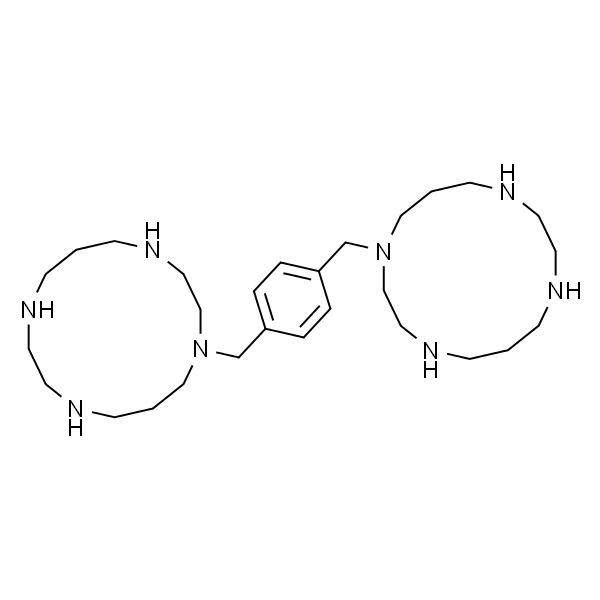| CAS |
110078-46-1 |
| Chinese Name |
普乐沙福 |
| English Name |
Plerixafor |
| Synonyms |
;普乐沙福;MOZOBILPLERIXAFOR;Mozobil;Unii-S915p5499n; |
| Molecular Formula |
C28H54N8 |
| Molecular Weight |
502.78 |
| Solubility |
Soluble in Ethanol |
| Purity |
≥98% |
| Appearance |
White to off-white Solid |
| Storage |
Powder:2-8℃,2 years;Insolvent(Mother Liquid):-20℃,6 months;-80℃,1 year |
| Delivery Time |
1-2 Days |
| EC |
EINECS 1592732-453-0 |
| MDL |
MFCD05662218 |
| SMILES |
C1(CN2CCCNCCNCCCNCC2)=CC=C(C=C1)CN3CCNCCCNCCNCCC3 |
| InChIKey |
YIQPUIGJQJDJOS-UHFFFAOYSA-N |
| InChI |
InChI=1S/C28H54N8/c1-9-29-15-17-31-13-3-21-35(23-19-33-11-1)25-27-5-7-28(8-6-27)26-36-22-4-14-32-18-16-30-10-2-12-34-20-24-36/h5-8,29-34H,1-4,9-26H2 |
| PubChem CID |
65015 |
| Target Point |
CXCR |
| Passage |
Immunology & Inflammation;GPCR & G Protein |
| Background |
Plerixafor is a selective CXCR4 antagonist. |
| Biological Activity |
Plerixafor是选择性的 CXCR4 拮抗剂,IC50值为44 nM[1-6]。 |
| In Vitro |
CXCR4抑制剂Plerixafor是CXCL12介导的趋化性(IC50,5.7 nM)的有效抑制剂,其效力略好于其对CXCR4的亲和力。用CCX771或CXCL11处理细胞对CXCL12介导的MOLT-4或U937 TEM没有影响。相比之下,10μMPlerixafor抑制两种细胞系中CXCL12介导的TEM [1]。与CXCL12刺激的细胞相比,Plerixafor(10μM)处理的细胞显示出细胞增殖的适度减少,这些细胞没有达到统计学意义[2]。 |
| In Vivo |
向UUO小鼠施用Plerixafor(2mg/kg)会加重肾间质T细胞浸润,导致促炎细胞因子IL-6和IFN-γ的产生增加,并且抗炎细胞因子IL-10的表达降低[3]。 。血管周围和间质纤维化在8周时被CXCR4拮抗剂Plerixafor显著降低[4]。 LD50,小鼠,SC:16.3mg/kg; LD50,大鼠,SC:> 50mg/kg; LD50,小鼠和大鼠,IV注射:5.2mg/kg。 |
| Cell Experiment |
将U87MG细胞以200μL/孔的密度接种于96孔板中,密度为6×103细胞,并用CXCL12,Plerixafor或肽R处理。在每个时间点加入MTT(5μg/ mL)(24,48),72小时)在最后2小时的治疗期间。除去细胞培养基后,加入100μLDMSO,用LT-4000MS微孔板读数仪在595nm处测量光密度。通过三次独立实验一式三份进行测量[2]。 |
| Animal Experiment |
小鼠[3]使用雄性C57bl/6小鼠(6-7周龄,体重20g)。这些动物适应住房环境,即SPF,温度为22°C,12h/12h光照/黑暗周期持续一周。然后,将它们随机分成以下实验组,每组8只小鼠:正常(无特异性干预),UUO + Plerixafor(小鼠接受UUO手术和2mg/kg AMD3100)和UUO + PBS(小鼠接受UUO手术)和相同体积的PBS)。每天通过腹膜内注射给予Plerixafor和PBS直至处死。大鼠[4]将CXCR4拮抗剂Plerixafor溶解于H2O中,以2mg/kg /天的剂量在2型糖尿病沙鼠模型中递送,持续8周。在补充研究中,检查了CXCR4拮抗作用(Plerixafor 6mg/kg/d)对调节性T细胞数量的影响。对于这些研究,AMD3100或车辆通过微型泵输送一周。 |
| Data Literature Source |
[1]. Zabel BA,et al. Elucidation of CXCR7-mediated signaling events and inhibition of CXCR4-mediated tumor cell transendothelial migration by CXCR7 ligands. J Immunol. 2009 Sep 1;183(5):3204-11.
[2]. Mercurio L,et al. Targeting CXCR4 by a selective peptide antagonist modulates tumor microenvironment and microglia reactivity in a human glioblastoma model. J Exp Clin Cancer Res. 2016 Mar 25;35:55.
[3]. Yang J,et al. Continuous AMD3100 Treatment Worsens Renal Fibrosis through Regulation of Bone Marrow Derived Pro-Angiogenic Cells Homing and T-Cell-Related Inflammation. PLoS One. 2016 Feb 22;11(2):e0149926.
[4]. Chu PY,et al. CXCR4 Antagonism Attenuates the Development of Diabetic Cardiac Fibrosis. PLoS One. 2015 Jul 27;10(7):e0133616.
[5]. He G,et al. SDF-1 in Mammary Fibroblasts of Bovine with Mastitis Induces EMT and Inflammatory Response of Epithelial Cells. Int J Biol Sci. 2017 May 5;13(5):604-614.
[6]. Wei He,et al. Targeting CXC motif chemokine receptor 4 inhibits the proliferation,migration and angiogenesis of lung cancer cells. Oncol Lett. 2018 Sep;16(3):3976-3982. |
| Unit |
Bottle |
| Specification |
5mg 10mg 50mg |


 English
English
 中文
中文

 Manual Download
Manual Download


